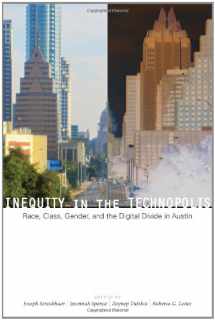
Inequity in the Technopolis: Race, Class, Gender, and the Digital Divide in Austin
ISBN-13:
9780292728714
ISBN-10:
0292728719
Edition:
First Edition
Author:
Joseph Straubhaar, Zeynep Tufekci, Jeremiah Spence, Roberta G. Lentz
Publication date:
2012
Publisher:
University of Texas Press
Format:
Hardcover
296 pages
FREE US shipping
Book details
ISBN-13:
9780292728714
ISBN-10:
0292728719
Edition:
First Edition
Author:
Joseph Straubhaar, Zeynep Tufekci, Jeremiah Spence, Roberta G. Lentz
Publication date:
2012
Publisher:
University of Texas Press
Format:
Hardcover
296 pages
Summary
Inequity in the Technopolis: Race, Class, Gender, and the Digital Divide in Austin (ISBN-13: 9780292728714 and ISBN-10: 0292728719), written by authors
Joseph Straubhaar, Zeynep Tufekci, Jeremiah Spence, Roberta G. Lentz, was published by University of Texas Press in 2012.
With an overall rating of 4.0 stars, it's a notable title among other
books. You can easily purchase or rent Inequity in the Technopolis: Race, Class, Gender, and the Digital Divide in Austin (Hardcover) from BooksRun,
along with many other new and used
books
and textbooks.
And, if you're looking to sell your copy, our current buyback offer is $0.33.
Description
Over the past few decades, Austin, Texas, has made a concerted effort to develop into a “technopolis,” becoming home to companies such as Dell and numerous start-ups in the 1990s. It has been a model for other cities across the nation that wish to become high-tech centers while still retaining the livability to attract residents. Nevertheless, this expansion and boom left poorer residents behind, many of them African American or Latino, despite local and federal efforts to increase lower-income and minority access to technology. This book was born of a ten-year longitudinal study of the digital divide in Austin—a study that gradually evolved into a broader inquiry into Austin’s history as a segregated city, its turn toward becoming a technopolis, what the city and various groups did to address the digital divide, and how the most disadvantaged groups and individuals were affected by those programs. The editors examine the impact of national and statewide digital inclusion programs created in the 1990s, as well as what happened when those programs were gradually cut back by conservative administrations after 2000. They also examine how the city of Austin persisted in its own efforts for digital inclusion by working with its public libraries and a number of local nonprofits, and the positive impact those programs had.


We would LOVE it if you could help us and other readers by reviewing the book
Book review

Congratulations! We have received your book review.
{user}
{createdAt}
by {truncated_author}


